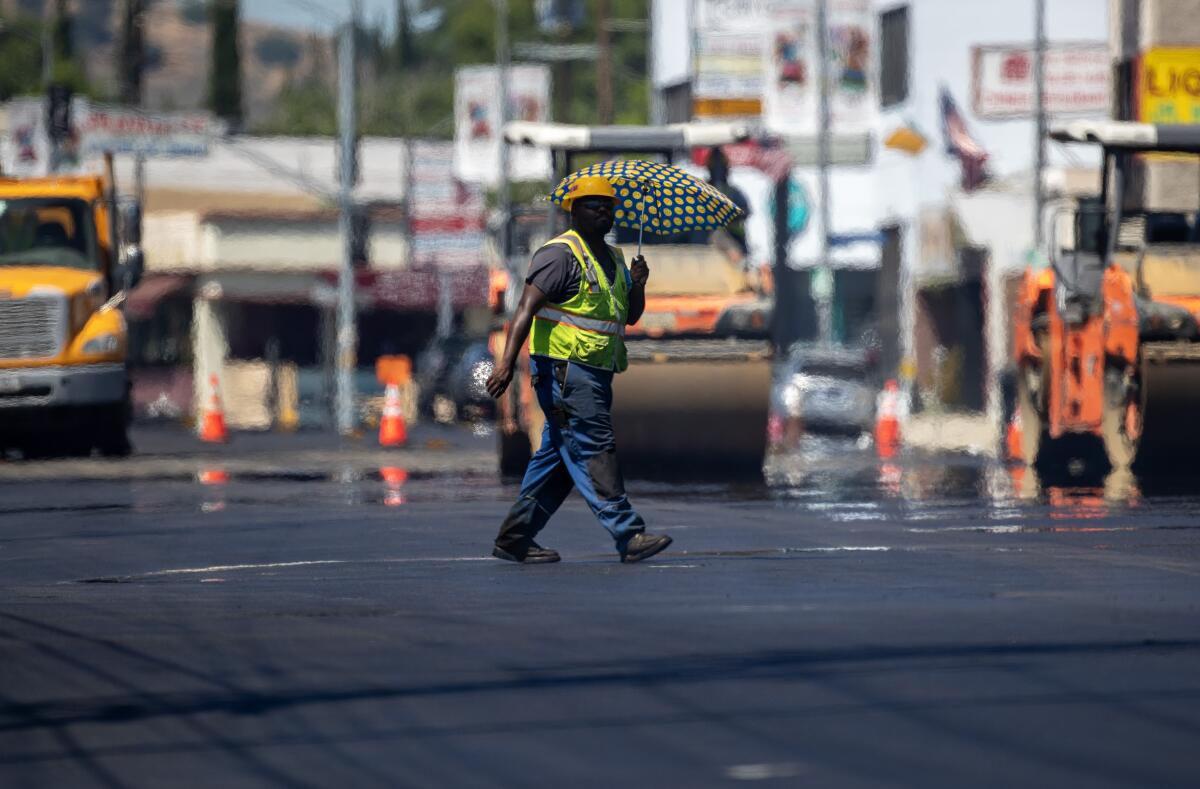Poll: California should do more to respond to extreme heat waves, voters say

- Share via
As California endures the increasing likelihood of record heat waves driven by climate change, voters are questioning government’s response to sweltering conditions and say they would welcome stronger policies to help minimize heat’s impact.
More than three-fourths of California voters — 77% — said they have recently experienced periods of extreme heat in their area, according to a new UC Berkeley Institute of Governmental Studies poll, co-sponsored by the Los Angeles Times. Voters living in the Inland Empire, the Central Valley and Los Angeles County reported the greatest impact on themselves and members of their immediate families.
By a large margin — 67% to 22% — voters supported the idea of the state establishing cooling standards for residential properties, similar to the heating standards currently in place. The standards would require air conditioners or other measures to keep indoor temperatures from rising to unsafe levels, a step that could be expensive for building owners, but potentially save many lives, according to health officials.
As the mercury rises, Californians offered mixed assessments of how their communities have responded with cooling centers and other opportunities for relief. Twenty-six percent of voters in affected areas rated their community as doing an excellent or good job; 23% fair and 23% poor or very poor.
The findings underscore a growing disquiet about the state’s climate future at a time when most experts say hotter, drier conditions are likely in the years and decades ahead. In July, global average temperatures increased 2.02 degrees above average, marking the planet’s hottest-ever month in at least 174 years of record keeping, according to the National Oceanic and Atmospheric Administration.
That month, a stifling heat dome settled over the Southwest and pushed temperatures in Phoenix to 110 degrees or hotter for a record 31 days straight. Death Valley soared to 128 degrees, while several areas in the Central Valley broke daily temperature records, including 113 degrees in Redding, 110 degrees in Bakersfield, and 109 degrees in Fresno, Madera, Hanford and Merced.
Marked by record-setting heat waves, major wildfires, and melting sea ice, July saw global average temperatures soar 2.02 degrees above average.
The fact that 77% of voters said they’ve recently experienced extreme heat was an important finding, said Mark DiCamillo, director of the IGS poll.
“I knew it would be a chunk of people, probably a majority, but 77% seems pretty high,” he said, noting the greatest impact has been on inland parts of the state.
Inland areas, as well as poor neighborhoods and communities of color, often bear the brunt of extreme heat events.
The idea of cooling standards for buildings, which the poll asked about, is under consideration in Los Angeles, where officials are studying the feasibility of a cooling mandate for rental units citywide.
A bill in the state Legislature, Assembly Bill 2597, similarly sought to require residential units to maintain adequate cooling but stalled in the Senate. A budget trailer bill adopted last year, Assembly Bill 209, kept the idea alive, however, and charged the Department of Housing and Community Development with studying the concept and submitting recommendations to the Legislature.
Mandatory cooling standards could pose challenges: More air conditioning would increase energy consumption, and the logistics of retrofitting old buildings could be complex, said Louis Blumberg, a climate policy advisor with the nonprofit group Climate Resolve. But it is also undoubtedly “the right thing to do.”
“There is a policy rationale for that and a moral one as well,” Blumberg said. “We require our dwellings to be safe. We do it for heat — you have to be able to keep the house from getting too cold. And in an era of warming temperatures, why would that not apply to keeping the house from getting too hot?”
A majority of voters, 70%, also supported a proposal in Congress to broaden federal disaster relief laws to include extreme heat as a form of natural disaster along with hurricanes, fires, landslides, drought and floods.
The Extreme Heat Emergency Act, introduced in June by Rep. Ruben Gallego (D-Ariz.), would give the Federal Emergency Management Administration, or FEMA, authority to provide support to local governments during extreme heat events.
Blumberg said heat was historically not included in disaster declarations because people tend to think of disasters in terms of property damage.
“Extreme heat does cause some property damage, but the biggest damage it causes is to health and to individuals,” he said. “So I think the next big policy shift is to understand that heat is a public-health crisis, and it causes significant negative impacts to people, including death.”
DiCamillo said he wasn’t surprised to see broad-based support for the policy questions.
“At a time when people are experiencing this extreme heat, you would expect there to be support for some kind of government action to minimize the impact, and we’re seeing that,” he said.
Previous Berkeley IGS polls — including a May poll about worsening weather swings — delivered more geographically and politically divided results. Support for both heat proposals received majority support among voters across all major regions of the state, DiCamillo noted.
Results were also more consistent across party lines, although Democrats tended to show more unanimous support for the policy proposals than did Republicans.
Read all of our coverage about how California is neglecting the climate threat posed by extreme heat.
The poll comes as California continues to receive scrutiny for its response to extreme heat. A 2021 Los Angeles Times investigation found that heat probably caused about 3,900 deaths in the state over the previous decade — six times the official tally.
Another heat wave last year pushed the state’s electric grid to the brink, prompting officials to send an emergency text alert to millions of residents asking them to immediately reduce their usage. Load on the grid went down by approximately 2,000 megawatts within half an hour of the alert, narrowly avoiding a blackout.
A full 50% of voters said they lack confidence in California’s ability to provide steady, reliable electric power during extended heat waves, the poll found.
“It’s consistent with the mixed views on how their communities are doing,” DiCamillo said. “Whether the state can actually follow through on delivering reliable power — half of the people say yes, half of the people say no.”
Despite high temperatures this summer, the state has so far been able to avoid a repeat of last year’s grid strain — something officials credited primarily to increased battery power and increased hydropower from historic winter storms.
But the effects of the 2022 heat wave still linger. Despite criticism, officials were not able to immediately provide data about how many people died during the record-breaking, 10-day heat wave. It was only this summer that state health officials reported an estimated 395 deaths from the event.
Experts say that’s still too slow, particularly since other states like Oregon and Washington already have the capability to conduct rapid assessments. But Blumberg said there has been some progress on that front, including $10 million toward an upcoming statewide heat surveillance system in California.
Editorial: The 2022 heat wave killed 395 Californians. It shouldn’t have taken so long to find out
We need better, more timely information on death and illness caused by heat waves, the deadliest climate-fueled disasters. Not just one off reports nearly a year after the fact.
Progress has also been made on a heat wave ranking system, which would categorize heat waves like hurricanes and other disasters to help raise awareness. The item, Assembly Bill 2238, passed last year, and officials are moving forward with the plan, Blumberg said.
Another awareness push, Gov. Gavin Newsom’s $20-million “Heat Ready CA” campaign, launched this summer and seeks to inform and warn residents about the dangers of extreme heat.
However, less progress has been made toward another important goal — heat standards for indoor workers. In places such as the Inland Empire, temperatures in warehouses can climb to 90 degrees or higher. Although state agencies are working toward a final regulation, progress has been “frustratingly slow,” Blumberg said.
He noted that extreme heat is the deadliest of all natural disasters, killing more people each year than hurricanes, tornadoes and other weather hazards, according to NOAA.
“We need to look at climate impacts from a people standpoint, and not only a property standpoint,” Blumberg said.
The Berkeley Institute of Governmental Studies’ poll surveyed 6,030 registered California voters online in English and Spanish, Aug. 24-29.
Because the survey results are weighted to match census and voter registration benchmarks, estimates of the margin of error may be imprecise; however, the results are estimated to have a margin of error of 2 percentage points in either direction for the full sample.
More to Read
Get the L.A. Times Politics newsletter
Deeply reported insights into legislation, politics and policy from Sacramento, Washington and beyond. In your inbox twice per week.
You may occasionally receive promotional content from the Los Angeles Times.











